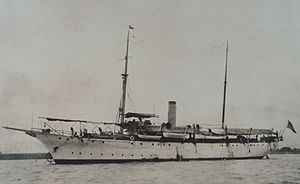USC&GSS Pathfinder (1899-1941)

The Coast and Geodetic Survey Ship Pathfinder in the Philippines in the early 1900s. This was the first Pathfinder. NOAA Photo Library: Image ID: ship0236, NOAA's Fleet Then and Now - Sailing for Science Collection
|
|
| History | |
|---|---|
|
|
|
| Name: | Pathfinder |
| Owner: | United States Coast and Geodetic Survey |
| Operator: | United States Coast and Geodetic Survey |
| Builder: | Crescent Shipyard at Morris Heights, New Jersey |
| Cost: | $169,993 |
| Completed: | 1898 |
| In service: | 1899-January 30, 1942 |
| Renamed: | Research 1941 |
| Fate: | Beached in a sinking condition January 30, 1942 |
| General characteristics | |
| Type: | Survey ship |
| Length: | 196.25 ft (59.82 m) |
| Beam: | 33.5 ft (10.2 m) |
| Draft: | 13 ft (4.0 m) |
| Depth of hold: | 19.66 ft (5.99 m) |
| Decks: | Three |
| Installed power: | Triple expansion steam engines developing 846 horsepower or 1,173 horsepower under forced draft |
| Sail plan: | Brigantine-rigged, 4,500 square feet of canvas |
| Speed: | 10.5 to 13 knots |
| Range: | 5,000 miles |
| Notes: | Specifically built for Alaska service |
The first USC&GSS Pathfinder, also noted in some NOAA histories as "old Pathfinder", was a United States Coast and Geodetic Survey Ship in service from 1899 to 1941 when she was beached in a sinking condition January 30, 1942 after 40 years (November 18, 1901 – January 30, 1942) service in the Philippines.
The Secretary of Commerce's Annual Report ending fiscal year 1900 contains the report of Frank Walley Perkins, Assistant, Coast and Geodetic Survey, Commanding, Pathfinder with the following a summary of his comments on construction and ship's characteristics.
The ship was built at the Crescent Shipyard, Elizabethport, New Jersey launched December 7, 1898. She was a three deck steel ship of extra strength built for work in the Aleutian Archipelago where strong currents, distances from supply bases required a vessel of considerable power and coal capacity. She had 15 water tight compartments with dimensions of 196' 3" over all, 33' 6" beam, 19' 8" "depth of hold" and equipped for sea draws 13'. She is brigantine-rigged with some 4,500 square feet of canvas and a single, 10' diameter 13' pitch, screw. Her vertical triple expansion steam engines with twenty-eight inch stroke developed 846 horsepower or 1,173 horsepower under forced draft with a speed of 10.5 to 13 knots. Her range was estimated at about 5,000 miles with a bunker capacity of 240 tons of coal. She was entirely steel with three decks This report begins using the name "U. S. S. Pathfinder," possibly causing some later confusion as the ship was always Coast and Geodetic Survey and never commissioned in the Navy.
According to an account by one of the ships' commanding officers she was "built by Lewis Nixon . . . using the plans of the Vanderbilt Yacht, the Nourmahal" because the appropriation was too small to cover the ship the Survey desired.
Frank Walley Perkins took command June 1, 1898 and on the 7th sailed to Hampton Roads with a 65-man Navy enlisted crew with Coast Survey officers. The ship was not equipped for the transit with deep-sea sounding equipment for survey work but there was hope for observations that could be made without the deep sounding gear.
...
Wikipedia
